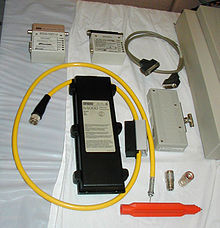Probably "Ethernet" is the most common type of LAN hardware. Ethernet cable consists of a single cable with host attached to it through connectors, taps or transceivers. Normally Ethernet cable has a net transfer rate of 10Mbps, 100Mbps or 1,000Mbps. Ethernets come in three flavors: thick, thin, and twisted pair.
Thin & Thick:
Use a coaxial cable, differing in diameter and the way you attach a host to this cable. Thin Ethernet use a T-shaped BNC connector, which you insert into the cable and twist onto a plug on the back of yur computer. The following two pictures showing you that a 10BASE2 cable with BNC connector end and a 10BASE2 cable with BNC T-connector.
Thick Ethernet requires that you drill a small hole into the cable, and attach a transceiver using a vampire tap. The following picture shows that a 10BASE5 transceivers, cables, and tapping tool. Another picture shows you that 10BASE5 cable with N connectors and transceivers.
Thin and thick Ethernet cable can run for a maximum of 200 and 500 meters respectively, that where the 10BASE2 and 10BASE5 is from. 10 stands for 10Mbps, 2 or 5 stands for the maximum length of the cable in hundreds of metres.
Twisted pair:
Twisted pair uses a cable made of two pairs of copper wires and usually requires additional hardware known as active hubs. Twisted pair is also known as 10base−T, the T meaning twisted pair. The 100 Megabits per second version is known as 100base−T. it has a maximum cable length of 100 meters.
One of the drawbacks of Ethernet technology is its limited cable length, which precludes any use of it other than for LANs. But you can use repeaters, bridges or routers to link several Ethernet segments togehter. Bridges and routers are more sophisticated. They can analyze incoming data and forward it only when the recipient host is not on the LAN.





No comments:
Post a Comment